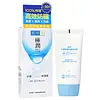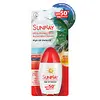What's inside
What's inside
 Key Ingredients
Key Ingredients

 Benefits
Benefits

 Concerns
Concerns

 Ingredients Side-by-side
Ingredients Side-by-side

Cyclopentasiloxane
EmollientWater
Skin ConditioningZinc Oxide
Cosmetic ColorantPEG-10 Dimethicone
Skin ConditioningDimethicone
EmollientMethylpropanediol
SolventTitanium Dioxide
Cosmetic ColorantSucrose Palmitate
EmollientVinyl Dimethicone/Methicone Silsesquioxane Crosspolymer
Silica
AbrasivePolyglyceryl-3 Polydimethylsiloxyethyl Dimethicone
Skin ConditioningPEG-9 Polydimethylsiloxyethyl Dimethicone
EmulsifyingMagnesium Sulfate
Hydrated Silica
AbrasiveTrimethylsiloxysilicate
EmollientDisteardimonium Hectorite
StabilisingPentylene Glycol
Skin ConditioningTriethoxycaprylylsilane
Hydrogenated Polyisobutene
EmollientSorbitan Isostearate
EmulsifyingButylene Glycol
HumectantAluminum Hydroxide
EmollientHydrogen Dimethicone
Propylene Carbonate
SolventInonotus Obliquus Extract
Skin ConditioningBisabolol
MaskingTheobroma Grandiflorum Seed Butter
Skin ConditioningCitrus Sinensis Peel Extract
PerfumingBiosaccharide Gum-1
HumectantYeast Polysaccharides
Skin ConditioningCitrus Limon Peel Oil
MaskingPelargonium Graveolens Flower Oil
MaskingCitrus Aurantium Bergamia Fruit Oil
MaskingElettaria Cardamomum Seed Oil
MaskingEctoin
Skin ConditioningHydrolyzed Sodium Hyaluronate
Skin ConditioningNiacinamide
SmoothingPhytic Acid
Sodium Hyaluronate
HumectantCaprylic/Capric Triglyceride
MaskingGlycerin
HumectantPolianthes Tuberosa Extract
MaskingCananga Odorata Flower Oil
MaskingZingiber Officinale Root Extract
MaskingSodium Lauroyl Lactylate
Emulsifying1,2-Hexanediol
Skin ConditioningLaminaria Ochroleuca Extract
Skin ConditioningPhenoxyethanol
PreservativeMoringa Oleifera Seed Extract
Skin ConditioningTheobroma Cacao Seed Extract
AntioxidantBiosaccharide Gum-4
Skin ConditioningCeramide NP
Skin ConditioningDisodium Phosphate
BufferingCeramide AP
Skin ConditioningCholesterol
EmollientCitric Acid
BufferingPhytosphingosine
Skin ConditioningMethylparaben
PreservativeCarbomer
Emulsion StabilisingXanthan Gum
EmulsifyingCeramide EOP
Skin ConditioningCyclopentasiloxane, Water, Zinc Oxide, PEG-10 Dimethicone, Dimethicone, Methylpropanediol, Titanium Dioxide, Sucrose Palmitate, Vinyl Dimethicone/Methicone Silsesquioxane Crosspolymer, Silica, Polyglyceryl-3 Polydimethylsiloxyethyl Dimethicone, PEG-9 Polydimethylsiloxyethyl Dimethicone, Magnesium Sulfate, Hydrated Silica, Trimethylsiloxysilicate, Disteardimonium Hectorite, Pentylene Glycol, Triethoxycaprylylsilane, Hydrogenated Polyisobutene, Sorbitan Isostearate, Butylene Glycol, Aluminum Hydroxide, Hydrogen Dimethicone, Propylene Carbonate, Inonotus Obliquus Extract, Bisabolol, Theobroma Grandiflorum Seed Butter, Citrus Sinensis Peel Extract, Biosaccharide Gum-1, Yeast Polysaccharides, Citrus Limon Peel Oil, Pelargonium Graveolens Flower Oil, Citrus Aurantium Bergamia Fruit Oil, Elettaria Cardamomum Seed Oil, Ectoin, Hydrolyzed Sodium Hyaluronate, Niacinamide, Phytic Acid, Sodium Hyaluronate, Caprylic/Capric Triglyceride, Glycerin, Polianthes Tuberosa Extract, Cananga Odorata Flower Oil, Zingiber Officinale Root Extract, Sodium Lauroyl Lactylate, 1,2-Hexanediol, Laminaria Ochroleuca Extract, Phenoxyethanol, Moringa Oleifera Seed Extract, Theobroma Cacao Seed Extract, Biosaccharide Gum-4, Ceramide NP, Disodium Phosphate, Ceramide AP, Cholesterol, Citric Acid, Phytosphingosine, Methylparaben, Carbomer, Xanthan Gum, Ceramide EOP
Cyclopentasiloxane
EmollientZinc Oxide
Cosmetic ColorantWater
Skin ConditioningEthylhexyl Methoxycinnamate
UV AbsorberTriethylhexanoin
MaskingDimethicone
EmollientTitanium Dioxide
Cosmetic ColorantPolymethyl Methacrylate
Lauryl PEG-9 Polydimethylsiloxyethyl Dimethicone
Skin ConditioningAcrylates/Dimethicone Copolymer
Skin ConditioningButylene Glycol
HumectantHydrated Silica
AbrasiveHydrogen Dimethicone
Diethylamino Hydroxybenzoyl Hexyl Benzoate
UV FilterBis-Isobutyl PEG/PPG-10/7/Dimethicone Copolymer
EmulsifyingAluminum Hydroxide
EmollientMethylparaben
PreservativeCyclotetrasiloxane
EmollientTocopheryl Acetate
AntioxidantTocopherol
AntioxidantCyclopentasiloxane, Zinc Oxide, Water, Ethylhexyl Methoxycinnamate, Triethylhexanoin, Dimethicone, Titanium Dioxide, Polymethyl Methacrylate, Lauryl PEG-9 Polydimethylsiloxyethyl Dimethicone, Acrylates/Dimethicone Copolymer, Butylene Glycol, Hydrated Silica, Hydrogen Dimethicone, Diethylamino Hydroxybenzoyl Hexyl Benzoate, Bis-Isobutyl PEG/PPG-10/7/Dimethicone Copolymer, Aluminum Hydroxide, Methylparaben, Cyclotetrasiloxane, Tocopheryl Acetate, Tocopherol
 Reviews
Reviews

Ingredients Explained
These ingredients are found in both products.
Ingredients higher up in an ingredient list are typically present in a larger amount.
Aluminum Hydroxide is a form of aluminum. It can be naturally found in nature as the mineral gibbsite. In cosmetics, Aluminum Hydroxide is used as a colorant, pH adjuster, and absorbent.
As a colorant, Aluminum Hydroxide may add opacity, or reduce the transparency. Aluminum hydroxide is contains both basic and acidic properties.
According to manufacturers, this ingredient is an emollient and humectant. This means it helps hydrate the skin.
In medicine, this ingredient is used to help relieve heartburn and help heal ulcers.
There is currently no credible scientific evidence linking aluminum hydroxide in cosmetics to increased cancer risk.
Major health organizations allow the use of aluminum hydroxide in personal care products and have not flagged it as a carcinogenic risk at typical usage levels.
Learn more about Aluminum HydroxideButylene Glycol (or BG) is used within cosmetic products for a few different reasons:
Overall, Butylene Glycol is a safe and well-rounded ingredient that works well with other ingredients.
Though this ingredient works well with most skin types, some people with sensitive skin may experience a reaction such as allergic rashes, closed comedones, or itchiness.
Learn more about Butylene GlycolCyclopentasiloxane, or D5, is a silicone used to improve texture of products and trap moisture.
D5 is considered lightweight and volatile. Volatile means it evaporates quickly after application. Once evaporated, D5 leaves a thin barrier that helps keep skin hydrated.
It is also an emollient. Emollients help soften the skin and prevent water loss. Silicones create a silky texture in products. D5 helps other ingredients become more spreadable.
Studies show D5 is safe to use in skincare products. We recommend speaking with a skincare professional if you have concerns.
Learn more about CyclopentasiloxaneDimethicone is a type of synthetic silicone created from natural materials such as quartz.
What it does:
Dimethicone comes in different viscosities:
Depending on the viscosity, dimethicone has different properties.
Ingredients lists don't always show which type is used, so we recommend reaching out to the brand if you have questions about the viscosity.
This ingredient is unlikely to cause irritation because it does not get absorbed into skin. However, people with silicone allergies should be careful about using this ingredient.
Note: Dimethicone may contribute to pilling. This is because it is not oil or water soluble, so pilling may occur when layered with products. When mixed with heavy oils in a formula, the outcome is also quite greasy.
Learn more about DimethiconeHydrated Silica is a type of silicon dioxide. It is called 'hydrated silica' because it is silica with extra bonded water atoms.
It is an absorbent and abrasive, meaning it is exfoliating.
Silica is often used for absorption and can help reduce shine when products are applied.
Learn more about Hydrated SilicaHydrogen Dimethicone is a type of silicone.
Methylparaben is a preservative and is a paraben. It is used to prevent the growth of fungus, mold, and other harmful bacteria. Parabens are chemicals used as preservatives in both cosmetics and food.
Methylparaben can be synthetically created. It can also be found naturally in some fruits, such as blueberries.
Oftentimes, Methylparaben is combined with other parabens to help increase the shelf life.
The safety of Methylparaben is currently being studied. While ongoing studies are looking into the safety of parabens, the results have been very mixed. Some studies have not found Methylparaben to be harmful.
Learn more about MethylparabenTitanium dioxide is a mineral UV filter widely used in sunscreens and cosmetics.
It is one of only two UV filters officially classified as “mineral” by regulatory agencies, the other being zinc oxide.
Titanium dioxide provides broad-spectrum protection mostly in the UVB and UVAII range, with some protection in the UVAI range.
While its UVA protection isn’t as strong as zinc oxide’s, the difference is minor.
A common myth is that mineral UV filters reflect UV light. However, modern research shows titanium dioxide absorbs UV radiation like chemical filters (~95% absorption & 5% reflection).
Thanks to its non-irritating nature, titanium dioxide is suitable for sensitive, acne-prone, or redness-prone skin. It is unlikely to cause "eye sting" like other sunscreen ingredients.
A major drawback of this ingredient is its white cast and thick texture. This is why mineral sunscreens often leave a white cast and are less cosmetically elegant than chemical/hybrid sunscreens.
To improve white cast and spreadability, micronized or nano-sized titanium dioxide is often used.
There are ongoing concerns surrounding nano-titanium oxide's impact on marine ecosystems.
There is no conclusive evidence that any form of titanium oxide (or any other sunscreen ingredients) will cause harm to marine ecosystems or coral reefs. The science is still developing but many consumers are keeping a close eye on this issue.
Please note, many destinations have reef-safety sunscreen rules. For instance, the U.S. Virgin Islands advises all visitors to use non-nano mineral sunscreens.
Nano mineral sunscreens once raised safety concerns about absorption into skin.
Extensive research has shown that they do not penetrate healthy or damaged skin; they remain safely on the surface and the top layer of dead skin (stratum corneum).
You'll likely find titanium dioxide bundled with alumina, silica, or dimethicone. These ingredients help make titanium dioxide highly photostable; this prevents it from interacting with other formula components under UV light.
Learn more about Titanium DioxideWater. It's the most common cosmetic ingredient of all. You'll usually see it at the top of ingredient lists, meaning that it makes up the largest part of the product.
So why is it so popular? Water most often acts as a solvent - this means that it helps dissolve other ingredients into the formulation.
You'll also recognize water as that liquid we all need to stay alive. If you see this, drink a glass of water. Stay hydrated!
Learn more about WaterZinc Oxide is a mineral broad-spectrum UV filter; it is the broadest UVA and UVB reflector approved by the FDA. It also has skin protectant and skin soothing properties.
Zinc oxide is one of the most effective broad-spectrum UV filters. It protects against UVB, UVAII, and UVAI. In comparison to its counterpart titanium dioxide, zinc oxide provides uniform and extended UVA protection.
Another great benefit? This ingredient is highly photostable so it won't degrade easily under sunlight.
A common myth is that mineral UV filters are widely believed to primarily reflect UV light.
However, modern research shows titanium dioxide absorbs UV radiation like chemical filters (~95% absorption & 5% reflection).
Zinc oxide has great skin soothing properties so you'll likely find this in sunscreens formulated for sensitive skin or babies/children. It is unlikely to cause "eye sting" like other sunscreen ingredients.
Regulatory agencies consider zinc oxide to be non-toxic and safe. It has also been shown to not penetrate the skin.
Unfortunately, this ingredient does leave a visible white cast. This is why mineral sunscreens are often less cosmetically elegant than chemical or hybrid ones.
In cosmetics, zinc oxide can be found in both non-nano and nano-sized forms. The nano version is used to reduce white cast and improve the texture of sunscreen formulas.
There are ongoing concerns surrounding nano-zinc oxide's impact on marine ecosystems and whether it can be absorbed into skin.
Regarding marine ecosystems and coral reefs, there is no conclusive evidence that any form of zinc oxide (or any other sunscreen ingredients) will cause harm. The science is still developing but many consumers are keeping a close eye on this issue.
Please note, many destinations have reef-safety sunscreen rules. For instance, the U.S. Virgin Islands advises all visitors to use non-nano mineral sunscreens.
There has also been some stir about whether micronized or nano zinc oxide has potential photoxicity and absorption through the skin/lungs.
An in-vitro (done in a test tube or petri dish) study demonstrated micronized zinc oxide to have potential phototoxicity. There's no need to fret; the EU Commission's Scientific Committee on Consumer Safety has stated, "The relevance of these findings needs to be clarified by appropriate investigations in vivo." Or in other words, further studies done on living organisms are needed to prove this.
Current research shows zinc oxide nanoparticles do not penetrate intact or sunburned skin. They either remain on the surface or in the outermost layer of dead skin (stratum corneum).
Zinc oxide is one of only two classified mineral UV filters with titanium dioxide being the other one.
Fun fact: Zinc has been used throughout history as an ingredient in paint and medicine. An Indian text from 500BC is believed to list zinc oxide as a salve for open wound. The Ancient Greek physician Dioscorides has also mentioned the use of zinc as an ointment in 1AD.
Learn more about Zinc Oxide